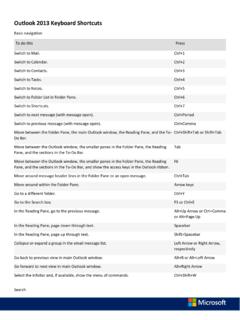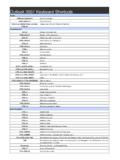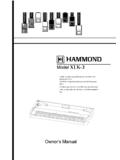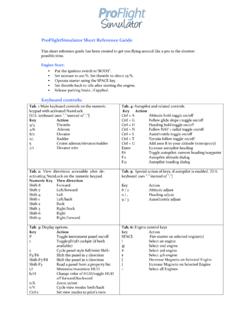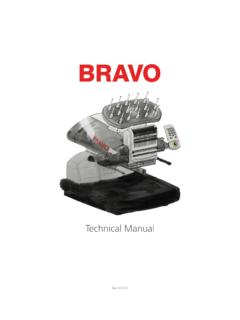Transcription of A Brief History of the Keyboard
1 A Brief History of the Keyboard By Sheau-Ping Hu Associate Professor, Music Department Fu Jen University, Taipei Taiwan In the early 1700 s there was a new invention that was to change the course of musical History . That new invention is what we commonly know today as the piano. Although a number of people had been experimenting with the sound production mechanism and produced functional instruments, it was Bartolomeo Cristofori of Padua, Italy who produced an important prototype that is generally recognized as the forefather of the piano as we know it today. It has been suggested that main reason Cristofori is considered the inventor of the piano is primarily due to the fact that three of his original pianos still exist today his 1720 54-note instrument (now in the Metropolitan Museum of Art in New York), his 1722 4-octave instrument (currently in the Museo degli Strumenti Musicali in Rome), and his 1726 4-octave piano (now in the Musikinstrumenten Museum at Karl Marx University in Leipzig, Germany.)
2 A Keyboard instrument produces sound through the vibration of strings. A string can be vibrated in four different ways: 1. It can be plucked with fingers. 2. It can be plucked with a plectrum (also known as a pick) 3. It can be struck with a mallet or hammer, as with the piano and clavichord. 4. It can be bowed, as with the violin and cello. The prototype of all stringed instruments was the monochord. The monochord was used by Pythagorus in 582 for exploring the mathematical relationships of musical sounds. It consisted of a single string stretched over a sound box and a movable bridge set on a graduated scale. Monochord The prototype of all stringed instruments which are struck is the dulcimer (sometimes called the hammer dulcimer ).
3 Originated in the Middle East, this instrument has existed since ancient times (its birth is placed in Medieval times, in the 12th Century), and still played all over the world, from the Near East to the Far East. A variation of the dulcimer known as the dulcimore is used widely in American folk music. The dulcimer normally consists of a flat case, trapezoidal in shape. It is struck by two small mallets, or hammers, held in each hand. Dulcimer A 14th century descendant of the dulcimer was know as the clavicytherium invented in Italy about 1300 (and afterwards copied and improved by the Germans), this is a Keyboard instrument in which the strings are arranged in the form of a triangle (like a harp), and sounded by the pricking of a quill plectra, fastened to the end of the clavis.
4 The strings were usually made of catgut. Clavicytherium Typical clavicytheriums were flat or horizontal but other models had the strings in an upright or vertical position. These other clavicytheriums, also known as upright harpsichords (cembalo verticale in Italian), looked much like harpsichords but with the string box standing straight up instead of laying flat. They were considered to be an ancestor of the modern upright piano. Upright Harpsichord (Italian: cembalo verticale) Improvements made in clavicytheriums by the Germans led to the development of the clavichord. The term clavichord appeared for the first time in 1484 in an English version of the tales and anecdotes of the French writer Rabelais Chavlier de la Tour Landry.
5 It was a descendant of the monochord, and the monochord s multi-chordal descendant, the manicorde. After acquiring a Keyboard , it became known as the clavichord. A struck instrument, the clavichord s case is in rectangular form with the Keyboard placed in front. The soundboard is located horizontally behind the Keyboard , with the strings running left to right. The strings, which are parallel to the Keyboard are stretched between fixed pins on one side, and tuning pegs on the other, and pass over a bridge. The strings are often in pairs. Clavichord The percussion instrument used to strike the strings of the clavichord is called the tangent. The tangent is a small blade of metal fixed at the extreme end of a wooden level, which is simply an extension of the key beneath the strings.
6 Unlike the modern piano, where each key has its own individual string, the clavichord has more keys than strings. This is because each string has more than one tangent. Therefore, the same string may be used to produce two (or more) different pitches, depending on which tangent is striking which part of the same string. In other words, tangents share strings, and as a result, on a clavichord several different pitches might be produced by striking the same string. In 1725, Daniel Faber of Germany developed the first clavichord to have one-key, one-string correspondence, or one string for each key. Prior to that, most clavichords had two to three keys to each string. The first clavichord had a range of only 3 or 3 diatonic octaves in C.
7 At first, the only accidental added to the Keyboard was B-flat. F-sharp was the next to follow. During the 15th and 16th centuries, the Keyboard became gradually chromatic. The oldest clavichord still in existence was built by Domenico Pisaurensis in 1543, and can be seen today in the instrumental Museum of Leipzig. Many composers came to prefer the clavichord to the harpsichord because of the clavichord s more expressive sonority and tone color. For example, composers like Bach, Bach, Mozart, and even Beethoven preferred the clavichord (often indicating for clavichord on their compositions). Although not a loud instrument, it had the disadvantage of greater volume control (and therefore, greater expressiveness) over plucked instruments of its day.
8 The spinet, also known as the virginal, was a type of small 16th century harpsichord whose name might derive from the fact that the instrument was pluched by a kind of spine (spina in Italian). The spinet s inventors were chiefly seeking to develop an instrument of greater tone production, one which could be heard in rooms larger than private salons - one which could make itself felt in an orchestral ensemble. The spinet is an oblong form, with a compass of 4 octaves. It has very long strings and a large soundboard compared to the clavichord and all other instruments of its time. The strings were plucked by a mechanical finger known as the jack. The jack is a small shaft of flat wood fixed upright at the felted far end of the finger-key.
9 Although this twanging of the string by the quill on the end of the jack produced a wiry, nasal tone, and the player could not play with any sonorous variation, the spinet became very popular because of its great, louder tone, and because it was portable and played on table tops. Spinet 1742 While known as the spinet in Germany, the instrument was known in England as the virginal. The instruments were mostly similar except for the fact that the virginal was built in smaller, lighter versions often carried by women. Technically, the spinet and virginal differed in that the spinet s strings were supported by bridges mounted on the soundboard, while the virginal s strings had no bridges. The exclusion of the bridge was done to reduce space, and therefore make the virginal more portable.
10 The sound of the virginal was hollow compared to the spinet. Virginal 1650 The harpsichord, a stringed instrument invented in the 16th century, was a plucked instrument similar in shape to the modern grand piano. The large size of the instrument was an effort to accommodate musicians desire for greater volume, something they were unable to achieve sufficiently with the clavichord. Early harpsichords were nothing more than enlarged spinets (larger case, greater soundboard, more strings, and longer strings). The harpsichord usually had two keyboards, with two or more strings for each note. Mechanically, the sounds of a harpsichord are produced in this way: when a key is depressed, the key raises the jack until the horizontally projecting plectrum plucks the string.


